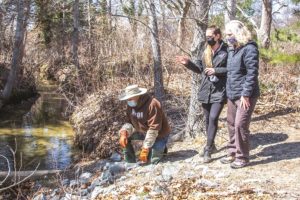EASTHAM — A scout was spotted by a natural resources dept. officer at the Bridge Pond run on March 12. A herring scout, that is — one of the individual fish that arrive early in the herrings’ seasonal migration into our tidal rivers to spawn.
Volunteers are preparing for the imminent arrival of the fish at Eastham’s Herring Pond and Bridge Pond runs, with plans for a Covid-safe count. The 2020 count was canceled due to the pandemic.
A first step involves monitoring water temperatures. “Because the temperature correlates well with the activity of the fish, that’s one of the pieces of information that’s been collected in the past by volunteers,” said Henry Lind, president of the Eastham Conservation Foundation. But, Lind said, “with Covid, that gets complicated, because it’s one more piece of equipment that somebody’s going to have to touch. This is entirely a no-touch kind of operation.”

The foundation implements the Mass Bays/Association to Preserve Cape Cod (APCC) herring count in Eastham. In spite of last year’s cancelation, Lind did experiment successfully with a submerged temperature recording monitor. Last Sunday, he placed the electronic device in the run.
“The only trick is making sure somebody doesn’t decide that’s a good souvenir to bring home,” said Lind. “It happens. It’s a public space.”
Volunteers will conduct random 10-minute counts from April 1 through June 1. The Mass. Div. of Marine Fisheries uses the data to monitor the health and well-being of the fishery, said Lind.
While some herring runs in the state use automatic counting devices, Lind pointed out the educational benefit of involving volunteers in the count.
“Having folks come here and get involved with the migration is probably far better than getting a more accurate or statistically correct number of how many fish came up,” said Lind, who retired in 2009 from his position as Eastham’s natural resources director. “Full disclosure,” Lind added: he gave up on electronic counting devices after trying to build some in the 1970s, “all of which failed in this run early on.”
Most herring runs open into marshes. But the one at Bridge Pond — also known as the Herring Brook run — opens straight into Cape Cod Bay. That’s why the natural resources dept. manages that run carefully throughout the migration, releasing herring from the pond depending on tides and other conditions to make sure the herrings’ access to the bay remains open.
“It’s very tide dependent,” explained Shellfish Constable Nicole Paine. “It’s not that big of a deal when the fish are migrating upstream to go into the run to spawn, but it becomes a very big problem when they’ve completed their spawning and they want to leave, or when the fry are ready to go out back into the ocean.”
Screens are placed in the gates to allow the water to flow but prevent the herring from leaving the pond on low tides, when thousands of fish could end up on the flats. Paine said that’s when they work to keep the fish in the pond, allowing them out only around the tides.
Signs at Bridge Pond instruct visitors not to tamper with the gates, as the release of fish at low tide can result in fish kills and predation. (The signs also warn that it is illegal to harvest, possess, or sell river herring in the commonwealth.)
“We do have a problem, every now and then, with people who want to be helpful,” said Paine. “They see the fish in the pond trying to get out, or they see fish trying to get in with the screen there, and they tamper with the gates. We’ll show up and the gate’s been lifted.”
The tide isn’t the only factor considered before the release of herring from Bridge Pond. Conditions at the bay end of the run are also evaluated. For example, on a hot day, Paine explained, when children are playing in the tidal pool at the end of the run, the gate is kept closed. That’s because the kids will scare the fish back upstream, after which the herring will try to get out at low tide.
According to a summary of volunteer herring counts on Cape Cod available on the APCC website, Eastham’s annual counts from 2014 to 2019 show a wide range. At Bridge Pond (a.k.a. Herring Brook) the lowest count during those six years was in 2016, when only 153 herring were spotted. The high was 1,068 in 2018. The low and high counts at Herring Pond tallied over a four-year period from 2016 to 2019 ranged from 15 in 2017 to 249 in 2018.
The Div. of Marine Fisheries uses the counts to calculate estimated sizes of the actual runs. The smallest and largest runs at Bridge Pond range from 1,932 to 12,716. At Herring Pond, the total run estimates range from 344 to 3,310.
The volunteer work getting underway now is appreciated, said Lind. “We’re very grateful for any help.”
Paine noted the volunteers seem to really enjoy their work. “They’re here in all kinds of weather,” she said. “In the pouring rain, they’re here counting fish.”
Anyone interested in volunteering for this year’s count should email the conservation foundation at [email protected].



